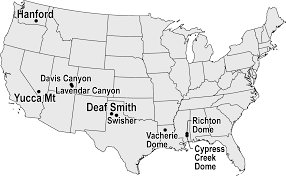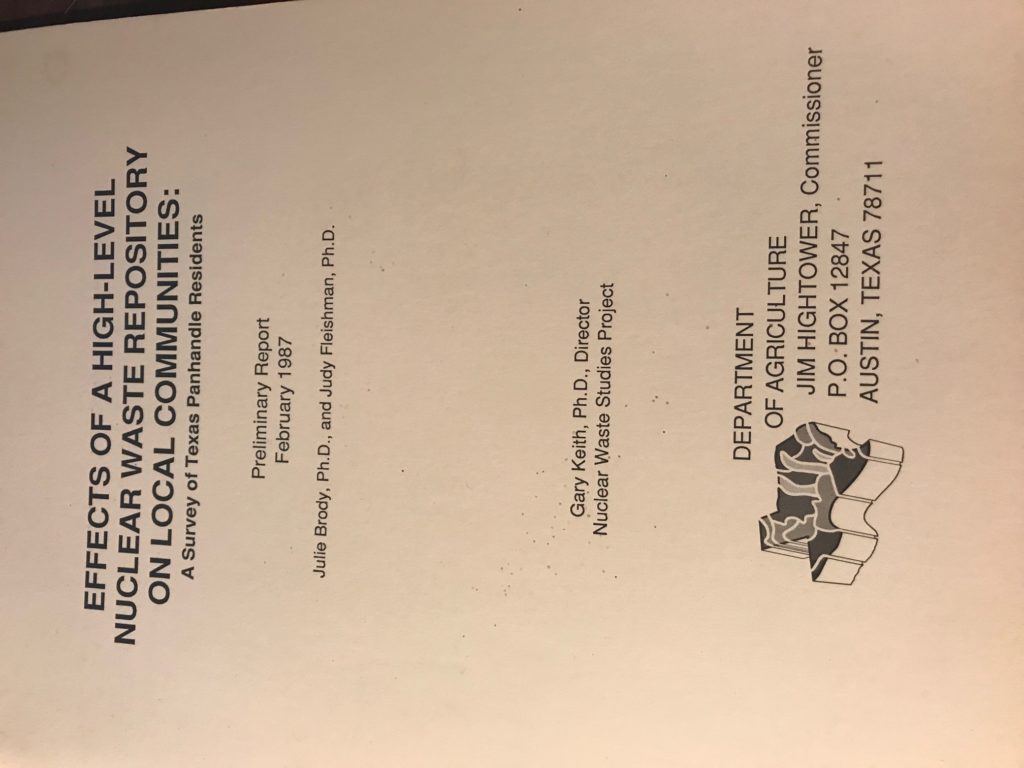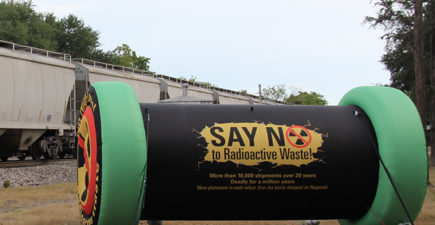
Texas Ag Department and Nuclear Waste
Billboard in Deaf Smith County
This is the first post on PHIT’s oral interviews with Texas Department of Agriculture Hightower years( 1983-1991). The goal of the TDA was to create an agricultural economic environment that would deliver food that was safe for the consumer, safe for the farmworker, safe for the planet, and would allow the family farmer and family rancher a decent living.
One of the Hightower’s administration’s longer lasting impacts for Texas was the TDA’s fight against the federal Department of Energy’s designation of Deaf Smith County as a national nuclear waste dump. Stopping a high level nuclear waste dump planned sited directly over the Ogallala Aquifer seemed like a no-brainer and the TDA assisted Deaf Smithians in fighting it.

Deaf Smith County is the number one farm county in the state. The landscape in this panhandle county is dotted with grain elevators and cattle feed yards. In summer, green fields of sugar beets, wheat, corn, sorghum and vegetables are irrigated with water from the Ogallala aquifer, the nations’ largest underground water supply. Firms in area include Frito-Lay, Holly Sugar, and Arrowhead Mills.
Yet, the Department of Energy, tasked with the problem of finding a storage dump for nuclear waste, picked Deaf Smith County, Yucca Flats, Nevada, and Hanford, Washington.
The plan was to inject the radioactive waste deep underground below the Ogallala via pipes that went through the Ogallala. Major processing firms based in Deaf Smith were already planning to move, because of the fear of possible contamination, mere rumors of which would spell consumer doom for their products. This, remember, was just a few years after Three Mile Island and historically, very soon, Chernobyl will implode.
The DOE had to make a decision by 1991. But Deaf Smith County didn’t want anything to do with it. Duh!
Gary Keith talked to PHIT about his involvement with that particular inane episode.
Gary Keith had contributed articles to the Texas Observer when Hightower was editor. He had been involved in Hightower’s Railroad Commission run. Although he left the state to be a professor up north, he wanted to get back to Texas, so he applied for a position at the House Study Group at the Texas legislature but, before that could happen, Hightower’s people plucked him off the waiver wire. He was recruited to work for the TDA in 1985.
One of his early chores at TDA was to respond to the nuclear waste dump proposal. State agencies don’t generally get involved in these sorts of issues and generally just rubber-stamp the federal proposal. But Hightower’s people thought they were supposed to protect the agricultural community and that included protecting water safety and promoting the availability of non-radioactive land. This is a prime example of the uniqueness of the TDA and why PHIT is collecting these stories.

By law, the DOE is supposed to survey the community about community support, but the DOE is rather lax about such things and the TDA acquired a grant for the DOE to conduct that community survey. Gary Keith described the process: “We put state money into it… when I say state money, what I mean is that our money came indirectly came from DOE. DOE was required to to engage with state and local entities. So DOE gave a grant to the governor’s office. The governor was Mark White and White knew that since this was a big agricultural area, there were big agricultural issues here and, and his guy Steve Frishman gave a grant to Hightower. So that is what we lived off of… this grant that came via DOE. Mark White, and Frishman had to publicly be neutral. But he was a supporter of us. He wanted us to do as much as we could. And then boom, White is defeated by Clements. And Clements stripped our money away. So that was the end of the project. But at about that same time, DOE designated Yucca Flats, Nevada, and so we were off the hook.”
“But it was a run for two to three years. Julie Brody…her field was community psychology… so she did surveys of residents. And then I did work more on the ground.”
The TDA couldn’t exactly do the organizing against the waste dump, but they could provide information and coordination and forums for discussions. So they assisted the local groups who had experience organizing against Pantex.
Gary Keith: “So it was, you know….you’re doing stuff that follows up on the earlier work that people did… Tani Adams had been active in battling against the expansion of Pantex. So she didn’t start from scratch either. There was an organization in place that, you know… you never want to have to keep doing something… but they did the Pantex work, and then lo and behold, along comes the high level nuclear waste possibility. So they geared up again, with some of the same people, same organizations. But some were new— one was STAND- Serious Texans Against Nuclear Dumping. And then there was the Nuclear Waste Task Force. So we had those local organizations that would have their meetings and we did what we could to support them. I brought in Scott Denman of the Safe Energy Community Council out of Washington DC. We did a workshop with the local groups in Amarillo on how to work the media.
‘You all be media advocates.’”

“We came up with a slogan, I can’t remember who did it, but it was at the same time that GSD& M was doing their Don’t Mess with Texas. Thing that we came up with was Don’t Waste Texas.”
The story however is never-ending as Texas continues its dance with the federals on the issue of nuclear disposal. Yucca Flats eventually opted out of being the waste disposal for the country. The United States is still looking for a place to dump its high-level radioactive trash. And they still have their eyes on Texas. In 2014, a proposal was floated for a dump site in Loving or Howard County.
Rick Perry defeated Hightower in 1990, and went on to become Governor of Texas. As Governor, Perry presided over the expedited permitting of a low-level nuclear waste disposal facility in Andrews County, in the Texas Panhandle. Dallas billionaire Harold Simmons, who in 1995 acquired Waste Control Specialists was a huge contributor to Perry in all his campaigns. Simmons’ new company wanted to dump low-level radioactive waste. The permitting was nasty and lengthy. Four major aquifers flow under the site in Andrews County; the Ogallala Aquifer flows 14 feet below the lowest extremity of the excavated nuclear waste disposal pit. But Simmons and Perry won that battle.
Oh, for the old TDA, the TDA that thought protecting agriculture meant protecting the safety of the Texas agricultural land.